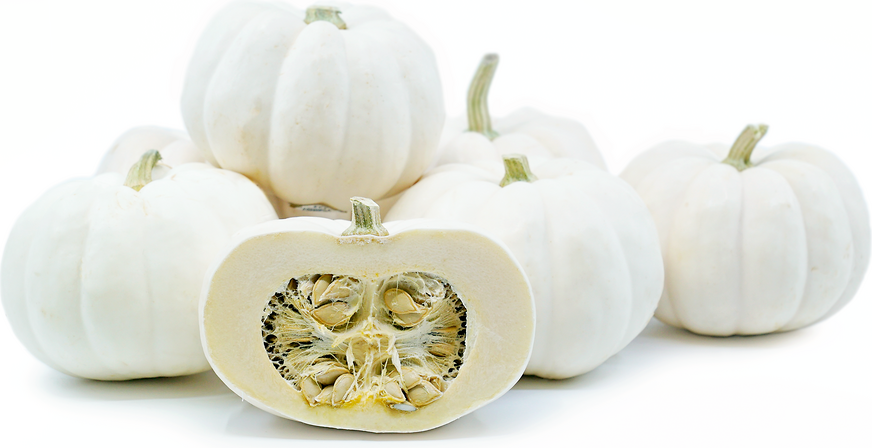


Mini White Pumpkins
Estimated Inventory, 50 ct : 0
This item was last sold on : 11/25/24
Description/Taste
Mini White pumpkins are small in size, averaging 5 to 8 centimeters in diameter and weighing around 113 to 450 grams each. They typically have a round, squat, and flat shape but may also feature an upside-down trapezoid form with straight sides and a rounded top. Their smooth rind is deeply ribbed and connects to a thin, light brown stem. This rind can be bright white or off-white with faint brown spotting. The firm and dense flesh ranges from bright orange to white and encases a central cavity filled with stringy pulp and many flat cream-colored seeds. When cooked, Mini White pumpkins are tender and sweet with nutty flavors reminiscent of Acorn squash.
Seasons/Availability
Mini White pumpkins are available from fall to winter.
Current Facts
Mini White pumpkins are botanically known as Cucurbita pepo and belong to the Cucurbitaceae family along with squash, gourds, and cucumbers. They are technically classified as gourds but are sold as pumpkins for marketing purposes. There are many different varieties of Mini White pumpkins including Baby Boo, White Gooligan, and Casperita. They develop on small creeping vines that can reach up to three meters long and grow on trellises and along fences. Home gardeners favor Mini White pumpkins for their resistance to disease, high yields, unusual color, and small size. They are often used as fall table decorations along with Mini Indian corn and colorful gourds. Mini White pumpkins are frequently implemented in do-it-yourself projects such as painting pumpkins, hollowing them out to make candle holders, or using them as serving bowls for soups and fall dishes.
Nutritional Value
Mini White pumpkins are a source of vitamin A, which supports healthy vision, immune function, and skin health. Their presence of vitamin B6 plays a key role in brain development and function while also helping maintain healthy metabolism and nerve function. Vitamin C is another key nutrient in Mini White pumpkins that boosts the immune system, promotes collagen production for healthy skin, and acts as an antioxidant. The vitamin E content in these crops helps protect cells from oxidative damage, supports skin health, and reduces inflammation. These pumpkins also contain lutein and zeaxanthin, two powerful antioxidants that are particularly beneficial for eye health, helping to filter harmful blue light and protect against age-related macular degeneration. The potassium in Mini White pumpkins helps regulate blood pressure, support muscle function, and maintain fluid balance in the body.
Applications
Mini White pumpkins are predominately used for ornamental purposes but some varieties are suitable for cooked applications such as roasting, steaming, and baking. Mini White pumpkins are commonly used as a serving bowl for savory dishes such as cheese sauces, dips, soups, curries, and stews. They can also be stuffed with meats, rice, and fall vegetables. In addition to savory dishes, Mini White pumpkins can be used as a ramekin for custards, pumpkin pie, crème brulee, apple crisp, and pumpkin cheesecake. Mini pumpkins pair well with maple syrup, black beans, quinoa, couscous, Brussel sprouts, cauliflower, mushrooms, garlic, red and green onions, currants, pine nuts, pecans, walnuts, cinnamon, sage, and thyme. They will keep for 6 to 12 months when stored in a cool and dry place.
Ethnic/Cultural Info
The tradition of pumpkin carving has deep roots in ancient Celtic practices. They were used during the Samhain festival which marked the end of the harvest and the beginning of winter. During this time, the Celts carved contorted faces into turnips and other root vegetables. They placed candles inside of them to ward off evil spirits. This custom was known as jack-o’-lanterns and evolved when Irish immigrants arrived in the United States in the 19th century and found that pumpkins were more readily available than turnips. They then embraced pumpkins as their new canvas and brought their tradition to the American mainstream. Today, pumpkin carving has evolved from a practice to ward off spirits to a fun and creative Halloween tradition. Mini White pumpkins have become part of this tradition and are often used in fall decorations alongside orange pumpkin varieties and other fall crops.
Geography/History
The exact origins of the Mini White pumpkin are unknown but varieties like the Baby Boo were developed by John Jaunsem in West Milton, Pennsylvania, in the 1990s. They grow best in warm climates with well-drained fertile soils. Mini White pumpkins are bred for their small size and white color and are mainly grown commercially or in home gardens. They gained popularity alongside other small pumpkin varieties in the 1980s and 1990s. These varieties are easier to grow and have become a favorite for autumnal decor during the Halloween season. Today Mini White pumpkins can be found at farmers' markets and specialty stores in North America.
Recipe Ideas
Recipes that include Mini White Pumpkins. One
| The New York Times |
|
Stuffed Baby Pumpkins |










